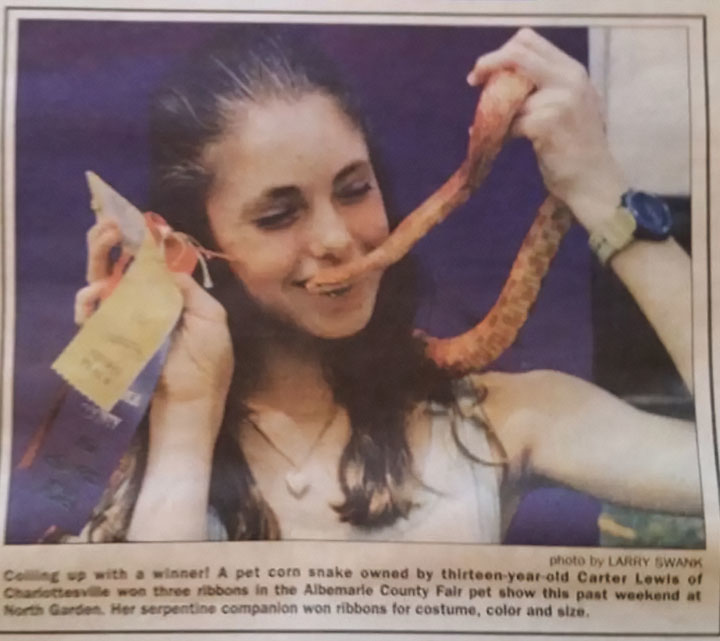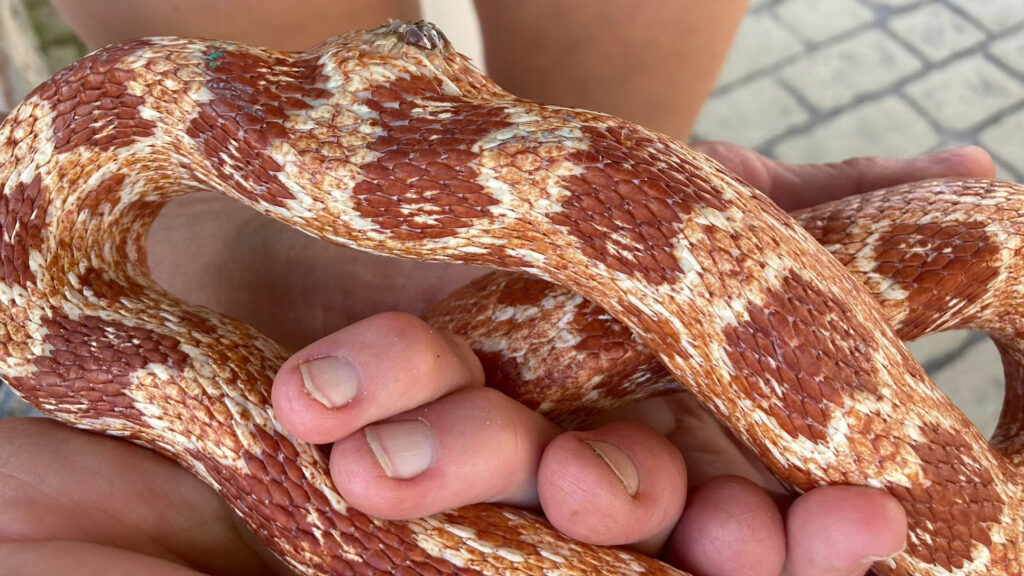Extraordinary Cancer Care for Long-Lived Companion Rusty the Corn Snake
“It’s really a great example of the human-animal bond,” says Professor Greg Lewbart of the relationship Carter Lewis had with her snake for more than a quarter century.

When most people think of getting a long-term pet companion, a corn snake probably isn’t the first animal that comes to mind, but Carter Lewis wouldn’t trade the 26 years she had with her Rusty for anything.
Lewis received the 2-year-old sweet serpentine sidekick as a present for her 12th birthday. Her father, a snake fancier, passed that trait along to his daughter. To Lewis, Rusty was just like another family member, and she even took him for walks in the yard – or, at least in Rusty’s case, for a slither.
It was a perfectly happy relationship. Until December 2021, when Rusty stopped eating.
It’s not unusual for snakes to go for extended periods without eating, but it was out of character for Rusty. As his indifference to nourishment extended into January 2022, Lewis began to seek medical advice.
Lewis, who lives in Virginia, visited local clinics and then expanded her search for answers over an increasingly wider area after only a small swelling in Rusty’s abdomen was noted. As her disappointment and expenses increased, she reached out in June to the NC State College of Veterinary Medicine.
At NC State, Lewis found a kindred spirit in Greg Lewbart, professor of Aquatic, Wildlife and Zoological Medicine. Lewbart also has a passion for reptiles, even having owned snakes himself, and is the founder of NC State’s thriving Turtle Rescue Team.
Lewbart was taken aback by Rusty’s age.
“He’s the oldest corn snake I’ve seen in my career,” he says. “I’ve never seen another over 20.”

Rusty had developed an obvious swelling on his left side, and Lewbart and colleague Tara Harrison, associate professor of zoo and exotic animal medicine, determined that the snake had a cancerous tumor – a sarcoma.
Both radiation and surgery were on the table, and despite his having lost weight, Rusty’s otherwise active behavior convinced Lewbart that he would be a good candidate for treatment despite his age. If treatment had not been in the snake’s best interest, Lewis and Lewbart wouldn’t have pursued it.
Lewbert says he was impressed by the relationship between Lewis and Rusty, whose favorite place to hang out was Lewis’ lap, and her determination to do all she could to help her companion.
“It’s really a great example of the human-animal bond,” Lewbart says.
Lewis was encouraged but concerned. Not only were the medical treatments costly, but the four-hour trip between Virginia and North Carolina also was increasingly expensive, especially with higher gasoline prices. Transporting Rusty to a series of radiation treatments or boarding him in Raleigh was going to be prohibitively expensive.
Fortunately, Lewbart was able to tell Lewis about funding available from the Petco Love and Blue Buffalo Cancer Treatment Fund. Through a generous grant to NC State, the fund helps clients defray the cost of cancer treatment for animal companions. Cases that might have otherwise gone untreated offer experience and information that helps advance the effort to fight cancer in both animals and humans.
“Rusty’s treatment wouldn’t have been possible without the Cancer Treatment Fund,” says Lewbert.
“It’s been so helpful,” Lewis adds. “I don’t know if I could have done it otherwise.”
Whether because of age or illness, Rusty passed away in October. Still, his story is an inspiring example of how a loving owner, compassionate veterinary medical care and generous donations to a worthy cause can work together to help our animal companions live their best lives and teach us more about cancer.



